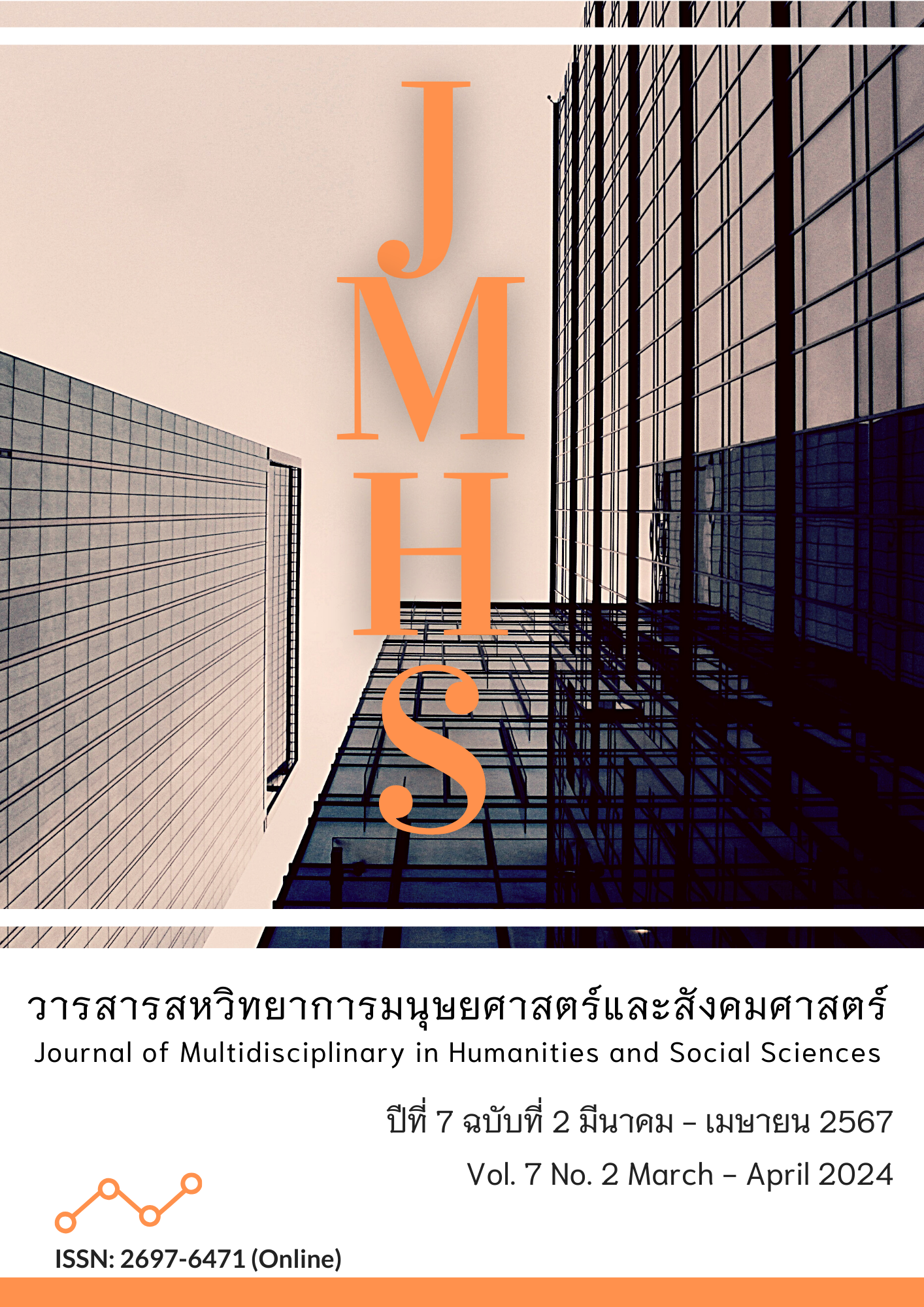Managing Cultural Tourist Attractions in the Old City of Tai Yo Chaiburi Subdistrict, Tha Uthen District, Nakhon Phanom Province
Main Article Content
Abstract
This study aimed to 1) explore the potential for cultural tourism attractions in the old Tai Yo City, and 2) promote the management of these cultural tourism sites in the old Tai Yai City, located in the Chaiburi Subdistrict, Tha Uthen District of Nakhon Phanom province. Using a qualitative research approach within a cultural tourism framework and management of cultural tourism attractions, data were gathered in Chaiburi Subdistrict, Tha Uthen District of Nakhon Phanom Province, through observations, surveys, and in-depth interviews. The study involved thirty informants and ten experts in group discussions, chosen through purposive sampling. The study’s analytical methods included content and descriptive analysis to illustrate the results. The findings were as follows:
1. The cultural tourism potential in the old Tai Yo City, highlighting several key attractions and related activities, such as 1) the scenic Chaiburi two-color river, 2) religious architectural sites (including Wat Traiphum, Wat Sri Bunrueang, Wat Klang Muang Chaiburi, Simwat Yod Kaew, and Phra Chai Rajawongsa (Ratchabut Sen) monument), 3) bicycle tours around the ancient city, and 4) participation in the Bun Bang Fai (Rocket) festival. These attractions are supported by initiatives from both the government and private sectors, fostering local employment, supporting local families, and promoting a circular economy within the community. 2. Additionally, the research identified five essential areas in the effective management of cultural tourism attractions in the old Tai Yo City: 1) management frameworks; 2) preservation and enhancement efforts; 3) development of guidelines or regulations for tourism attractions; 4) strategic public relations; and 5) the creation of a network among tourism sites.
This study contributes valuable insights into cultural tourism management in the old Tai Yo City, emphasizing the importance of conserving cultural and traditional heritage, maintaining community cultural resources without altering the local way of life, and generating income to elevate the community’s quality of life.
Article Details

This work is licensed under a Creative Commons Attribution-NonCommercial-NoDerivatives 4.0 International License.
Views and opinions appearing in the Journal it is the responsibility of the author of the article, and does not constitute the view and responsibility of the editorial team.
References
กรมส่งเสริมวัฒนธรรม. (2564). แผนปฏิบัติราชการ 4 ปี (พ.ศ. 2565-2568). กรุงเทพฯ: กระทรวงวัฒนธรรม.
กระทรวงการท่องเที่ยวและกีฬา. (2550). คู่มือเครือข่ายการท่องเที่ยวโดยชุมชน. (พิมพ์ครั้งที่ 3). กรุงเทพฯ: สำนักงานพัฒนาการท่องเที่ยว.
กระทรวงการท่องเที่ยวและกีฬา. (2562). แผนปฏิบัติการขับเคลื่อนการพัฒนาการท่องเที่ยวโดยชุมชนอย่างยั่งยืนและสร้างสรรค์ พ.ศ. 2561-2565 และเกณฑ์คัดเลือก 303 ชุมชน. สืบค้นเมื่อ 30 มกราคม 2566, จาก https://www.mots.go.th
คณะกรรมการนโยบายการท่องเที่ยวแห่งชาติ. (2560). แผนพัฒนาการท่องเที่ยวแห่งชาติ ฉบับที่ 2 พ.ศ. 2560-2564. (พิมพ์ครั้งที่ 2). กรุงเทพฯ: องค์การสงเคราะห์ทหารผ่านศึก.
จุฑาภรณ์ ทองเพ็ง. (2554). ความเห็นของนักท่องเที่ยวที่มีต่อการจัดการท่องเที่ยวเชิงวัฒนธรรมของวัดโสธรวรารามวิหารจังหวัดฉะเชิงเทรา. มหาวิทยาลัยบูรพา.
ณัฐกานต์ เพ็งหาพันธ์. (2554). การพัฒนาศักยภาพด้านการท่องเที่ยวเชิงวัฒนธรรม อำเภอเชียงคาน จังหวัดเลย(ปริญญานิพนธ์บริหารธุรกิจมหาบัณฑิต). มหาวิทยาลัยขอนแก่น.
ธนรัตน์ รัตนพงศ์ธระ. (2560). แผนยุทธศาสตร์เพื่อพัฒนาศักยภาพการท่องเที่ยวเชิงมรดกวัฒนธรรมแบบบูรณาการอย่างยั่งยืนจังหวัดพระนครศรีอยุธยา (ปริญญานิพนธ์ปรัชญาดุษฎีบัณฑิต). มหาวิทยาลัยพะเยา.
บุญเลิศ จิตตั้งวัฒนา. (2557). อุตสาหกรรมการท่องเที่ยว. กรุงเทพฯ: ศูนย์วิชาการท่องเที่ยวแห่งประเทศไทย.
ปรัชญาพร พัฒนผล. (2554). การพัฒนาเส้นทางการท่องเที่ยววัฒนธรรมแม่น้ำเพชรบุรี(ปริญญานิพนธ์ศิลปศาสตรมหาบัณฑิต). มหาวิทยาลัยธรรมศาสตร์.
มนัส สุวรรณ และคณะ (2541). การจัดการการท่องเที่ยว. (พิมพ์ครั้งที่ 8). กรุงเทพฯ: ไทยวัฒนาพานิช.
วันสาด ศรีสุวรรณ. (2553). รูปแบบการจัดการท่องเที่ยวเชิงวัฒนธรรม โดยการมีส่วนร่วมของชุมชนลุ่มน้ำตาปี(ปริญญานิพนธ์ปรัชญาดุษฎีบัณฑิต). มหาวิทยาลัยมหาสารคาม.
ศศิธร เชิงหอม. (2552). การพัฒนาการท่องเที่ยวเชิงวัฒนธรรมบ้านพันนา ตำบลพันนา อำเภอสว่างแดนดิน จังหวัดสกลนคร(ปริญญานิพนธ์ศิลปศาสตรมหาบัณฑิต). มหาวิทยาลัยราชภัฏสกลนคร.
ศิรินันทน์ พงษ์นิรันดร และคณะ. (2559). แนวทางในการพัฒนาศักยภาพการจัดการท่องเที่ยว อำเภอวังน้ำเขียว จังหวัดนครราชสีมา. วารสารวิทยาลัยบัณฑิตศึกษาการจัดการ มหาวิทยาลัยขอนแก่น, 9(1), 234-259.
สัญญา สะสอง. (2563). การจัดการท่องเที่ยวเชิงวัฒนธรรมผ่านการมีส่วนร่วมของกลุ่มชาติพันธุ์ไทใหญ่ หมู่บ้านแพมบก อำเภอปาย จังหวัดแม่ฮ่องสอน. วารสารวิชาการวิทยาลัยบริหารศาสตร์, 3(1), 35-46.
สมเกียรติ ชัยพิบูลย์. (2550). การจัดการท่องเที่ยวเชิงวัฒนธรรม กรณีศึกษา ศักยภาพการท่องเที่ยวชุมชนนครชม อำเภอเมือง จังหวัดกำแพงเพชร. กำแพงเพชร: สำนักวิทยบริการและเทคโนโลยีสารสนเทศ มหาวิทยาลัยราชภัฏกำแพงเพชร.
อารีย์ นัยพินิจ และ ฐิรชญา มณีเนตร. (2551). การมีส่วนร่วมของคนในชุมชนในการจัดการการท่องเที่ยวหมู่บ้านบุไทรโฮมสเตย์ อำเภอวังน้ำเขียว จังหวัดนครราชสีมา. ขอนแก่น: คณะวิทยาการจัดการ มหาวิทยาลัยขอนแก่น.
Chantawanich, S. (2010). Qualitative research methods (11th ed.). Bangkok: Chulalongkorn University Press.

